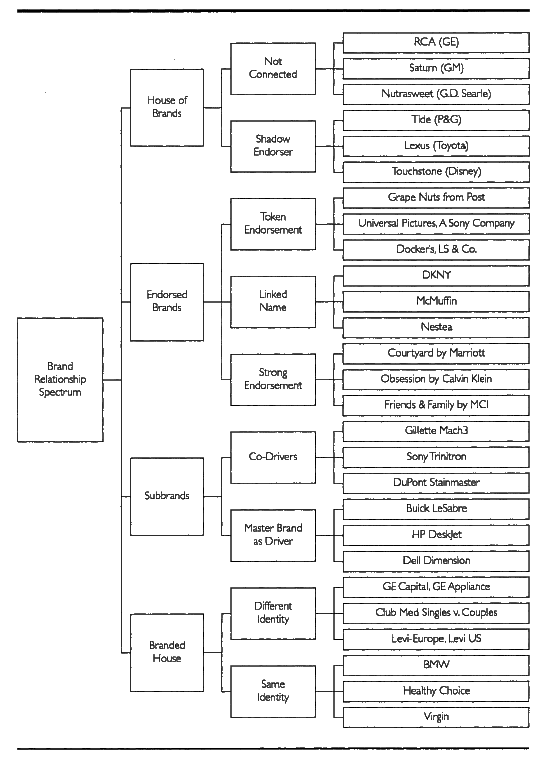In his paper The Brand Relationship Spectrum: The Key to the Brand Architecture Challenge, Erich Joachimstaler explains how brands and the nature of branding have become increasingly more and more complex as they have developed over time. The relationships and structures that contemporary brands are composed of present a set of challenges for building recognizable, distinguishable brands that lend themselves to the experience of the modern consumer. The Brand Relationship Spectrum is a brand architecture tool that establishes a concrete, systematic, approach to branding.
The Brand Relationship Spectrum
The Brand Relationship Spectrum is composed of four basic strategies which feed into nine sub-strategies. The four basic strategies are: House of Brands, Endorsed Brands, Sub-brands and Branded house.
The House of Brands
The House of Brands strategy, “involves an independent set of stand-alone brands, each maximizing the impact on a market.” This is best laid out by the two identifying sub-strategies: Not Connected and Shadow endorser. A brand that is Not Connected, is one that is completely independent of the company or brand that takes ownership of it, an example being the relationship between Saturn and GM. On the other hand, a Shadow Endorser is a brand that, “is not visibly connected to its endorser brand, but many consumers know about the link.” For example, Toyota is the Shadow Endorser of Lexus.
Endorsed Brands
Endorsed Brands, the second of the four main strategies, are independent brands that “are still independent, but they are also endorsed by another brand, usually an organizational brand.” The corresponding sub-strategies: Token Endorsement, Linked Name and Strong Endorsement, reflect the level of endorsement an endorser brand plays in the space of an endorsed brand. There is a subtle yet crucial point of differentiation between a Token Endorsement brand such as Universal Pictures, A Sony Company and McMuffin, a Linked Name brand which is linked to McDonalds via the “Mc.” The most distinct of these sub-strategies is Strong Endorsement, as in Courtyard by Marriot, where the endorser brand is an inextricable part of the endorsed brand’s name and identity.
“This set of challenges has created a new discipline that can be labeled ‘brand architecture’ because it deals with relationships and structures not unlike those facing an architect who must design the structure and layout of rooms, buildings, and cities.”
Sub-Brands
The third strategy within the Brand Relationship Spectrum is Sub-brands. These brands are, “connected to a master or parent brand and augment or modify the associations of that master brand.” Sub-brands require a master brand or “driver” of which there are two kinds, representing[ the sub-categories that fall under the umbrella of Sub-brands: Co-Driver and Master Brand as Driver. A Co-Driver situation, such as Gillete Mach 3, is defined by both the master brand and the sub-brand having major driver roles. Buick LeSabre is a situation in which the master brand is the driver, because the sub-brand is simply a name that differentiates on product functionality.
A Branded House
The spectrum’s two ends present a nearly circular finish as the fourth sub-strategy is called A Branded House. This strategy places an emphasis on the master brand in which it, “moves from being a primary driver to a dominant driver role across multiple offerings.” There are two ways or sub-strategies by which to approach this method: Different identity or Same Identity. The former is exemplified by the relationship between Levi Europe and Levi US. Two separate identities which stem from the same brand in order to align with differentiating markets. The latter is personified by BMW. No matter where in the world you go, a BMW is a BMW.
The Brand Relationship Spectrum is not a completely finite way of developing brand architecture. There are combinations of different strategies and sub-strategies that can be used. The key is to tailor a brand architecture to the specifications of the brand because using too many, too few or the entirely wrong strategies and sub-strategies can prove highly ineffective.

